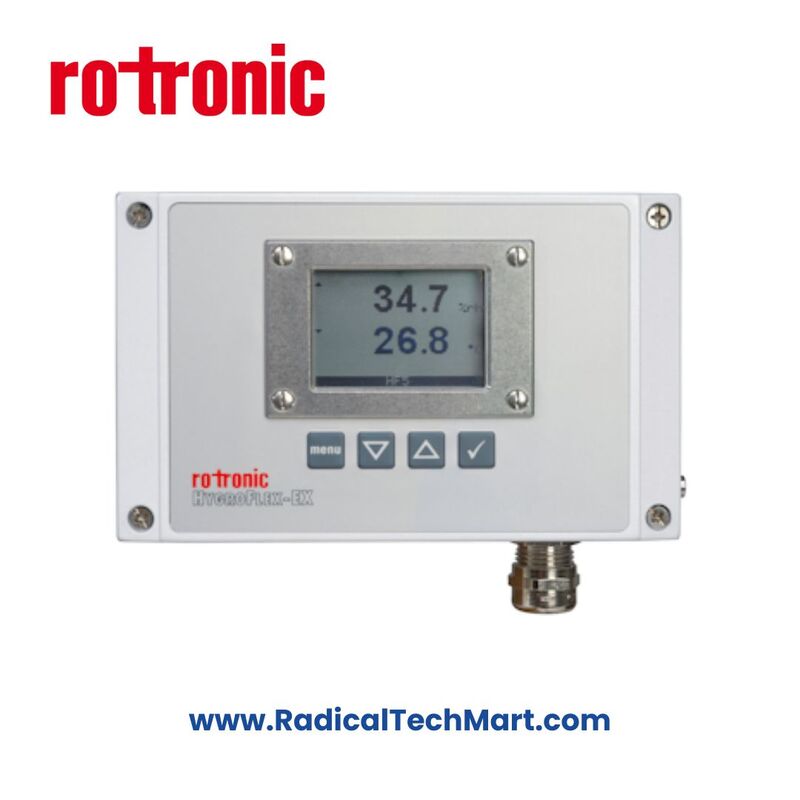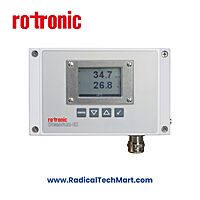




Rotronic HF5-EX Series Humidity & Temperature Transmitter
Rotronic HF520-EX HygroFlex5-EX – Ex-Proof Humidity & Temperature Transmitter
Explosion-protected aluminum transmitter for humidity, temperature, and dew point measurement in ATEX Zone 1/21 and Zone 0/20 environments.
The Rotronic HF5-EX series is a high-precision, two-channel humidity and temperature transmitter designed for use in hazardous, explosive atmospheres. Built with a robust aluminum housing and certified to international standards, it's ideal for critical industrial applications.
VERSIONS
HF520-EX-W – Wall Version
Robust aluminum housing (IP66)
Integrated EX-approved stainless-steel probe (HC2-SM-EX)
LCD (optional) for local indication
Suitable for ATEX Zone 1/21
HF520-EX-D – Duct Version
Same aluminum transmitter as wall version
Probe mounted through duct using AC1301-MEX gland
Uses HC2-SM-EX or HC2-IM-EX probes
Suitable for ducts in hazardous areas
Wall Version with Cable Sensor (Flexible Probe)
Remote EX cable probe: HC2-IMxxx-EX
2 / 5 / 10 m cable lengths
130 / 280 mm stainless-steel probe
Good for placement away from electronics and confined spaces
Wall Version with Screw-In Sensor
EX screw-in probes: HC2-IExxx-EX or HC2-LDPxxx-EX
½” G or NPT threaded connection
Suitable for pressure pipes, low dew point, or high-pressure HVAC
Key Features
ATEX/IECEx approved for Zone 1/21 (transmitter) and Zone 0/20 (probes)
Stainless-steel EX probes
Measures RH, Temperature & Dew Point
Two scalable analog outputs (2 × 4–20 mA, two-wire)
IP66 aluminum enclosure
LCD display optional
Interchangeable EX probes
Power supply: 10–28 VDC
Technical Specifications
Parameter Value Humidity Range 0–100% RH Accuracy at 23°C 0.8% RH / 0.1 K Temperature Range –40…60°C or –40…85°C (probe-dependent) Outputs 2 × 4–20 mA (2-wire) Housing Aluminum EN AC-AlSi12, IP66 Display Optional LCD (no backlight) Start-Up Time <60 s cold / <30 s warm EX Protection II 2(1)G Ex eb mb [ia Ga] IIC T5 Gb Probes HC2-SM-EX / HC2-IM-EX / HC2-IE-EX / HC2-LDP-EX
| Parameter | Value |
|---|---|
| Humidity Range | 0–100% RH |
| Accuracy at 23°C | 0.8% RH / 0.1 K |
| Temperature Range | –40…60°C or –40…85°C (probe-dependent) |
| Outputs | 2 × 4–20 mA (2-wire) |
| Housing | Aluminum EN AC-AlSi12, IP66 |
| Display | Optional LCD (no backlight) |
| Start-Up Time | <60 s cold / <30 s warm |
| EX Protection | II 2(1)G Ex eb mb [ia Ga] IIC T5 Gb |
| Probes | HC2-SM-EX / HC2-IM-EX / HC2-IE-EX / HC2-LDP-EX |
Applications
Hazardous industrial zones
Petrochemical plants
Pharmaceutical production
ATEX HVAC systems
Silos, dust-hazard zones
Pressure pipes & low-dew-point monitoring
What’s in the Box
HF520-EX transmitter (Wall / Duct / Cable Probe / Screw-in Probe version)
EX probe (model-dependent)
Cable gland AC1301-MEX (for duct/cable types)
Mounting hardware
Documentation
❓ FAQ
Q: Are the probes interchangeable?
Yes, all EX probes (HC2-SM-EX, IM-EX, IE-EX, LDP-EX) can be swapped.
Q: Can this model measure dew point?
Yes, all psychrometric calculations are supported.
Q: Can I calibrate the probe in a safe zone?
Yes—probes can be removed and calibrated outside the EX area.